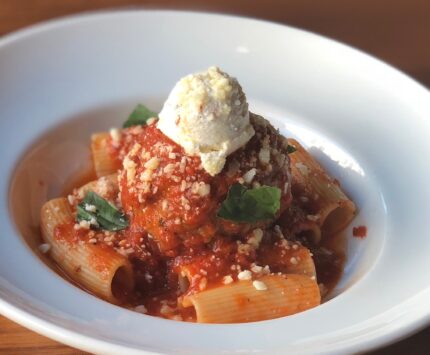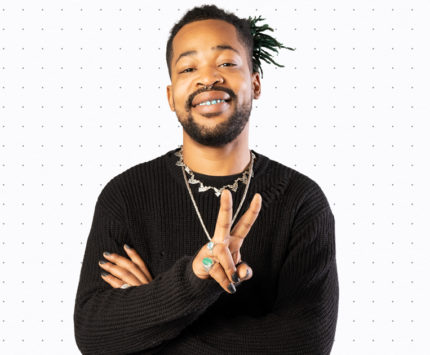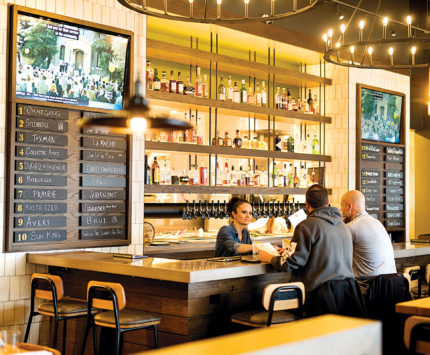Shawn Michael Warren On His Major Taylor Mural

Photo by Katrina Wittkamp
Had you heard of Major Taylor before applying for this mural project?
I was familiar with who he was, but I didn’t know that he was the first African-American world champion cyclist.
Why did you decide to do the mural in monochrome rather than color?
Because there are no color images of him. But I paint the majority of my large-scale murals in monochrome. I believe it looks very timeless. It’s a theme I’ve done for the last several years, and I definitely see myself continuing down that path.
So how is working on a gigantic mural different from doing more manageable projects, like paintings?
The main thing is control. When you’re working on canvas in a studio, you have control over everything, from the concept to what the final painting looks like. You have no outside voices to consider, and everything is completely autonomous.
Do murals, because they’re so public and large, have more stakeholders?
Yes, I have to go in knowing that there will be a lot of other voices to consider. There are the financial backers, city ordinances to comply with, permits and approvals from city officials, input from area residents. But it’s important to have feedback from them, because you want to accurately reflect the neighborhood or the city in which this work of art is going to be.
How physically hard is painting a mural? This one is five stories tall and around 20 feet wide.
Doing a multistory work of art, as opposed to something life-sized in a studio, is very taxing physically. And there’s a much higher level of unpredictability than when you’re working in a studio. My approach has to be more calculated and mechanical, because there’s a deadline that has to be met and you have to work efficiently.
You originally pitched a plan to create the picture on a lightweight material in Chicago, then apply it to the wall in strips. What happened?
There was concern that the original approach would possibly damage the wall. So instead, I’ve been painting it on site. I just had to adjust my schedule so that I’m down there for an extended period of time. You’re at the mercy of the elements, while working in a studio allows you to do it in a temperature-controlled space where you don’t have to stop at nightfall or when it starts raining.
You’ve been up there on a cherry picker for weeks. Do you have a problem with heights?
Thankfully, heights aren’t a big deal for me. I’ve been on multistory projects before, and it’s OK as long as the equipment functions properly.
Indianapolis seems to really, really like murals lately. Is the entire country going through “mural mania” right now?
Well, having worked in Los Angeles for the last five years, I’d say they were pretty common already. L.A. is the mural capital of the country. Nationally, I’m not sure what started the latest wave of interest. But there has definitely been a renewed appreciation for public art. In Chicago, it has been a breath of fresh air to see all of the public art initiatives in recent years. I’m not sure what triggered the phenomenon, but it’s something that needs to continue. Art needs to be accessible to everybody.
How many projects do you work on at once?
Right now, there are two—this one, and a project for the University of Chicago Law School. They commissioned me to create a portrait of one of their alumni, Earl B. Dickerson, the first African American to earn a juris doctor from the school. This will be the first time they will have a portrait of an African-American alumnus there. It’s being done on the centennial of his graduation.
You don’t shy away from political commentary in your work. How political could you get with a gigantic mural that had to pass through so many committees and satisfy so many interests?
I think the picture is still a statement, because of who Major Taylor was, the times in which he lived, and how he was treated in Indianapolis during that time. We’re talking about someone who faced very ugly forms of racism and had to push through that to become one of the most dominant athletes of his time. Elements of the American flag were part of his uniform, but he was representing a country that didn’t even see him fully as a man and certainly didn’t treat him in the most humane way. Given all that, I think it’s sort of bold to depict him on such a large scale, so that we can’t ignore him. It will cause people to ask questions that might feel uncomfortable, but are necessary.
So what do you hope the casual viewer takes away after seeing the mural?
I don’t want them to just see an athlete. I want them to see someone who carried himself with grace and pride and humanity. That has to be just as important as his athletic accomplishments.





